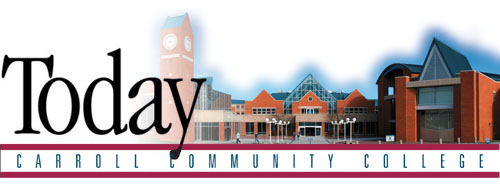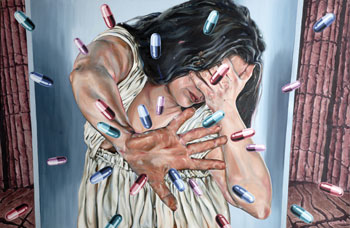
| Fall 2008, No. 39 |
|
ContentsBoard of Trustees Approves Smoke-Free Campus Carroll Receives Third National Technology Award Summer Kids@Carroll Receives LERN Recognition Kristine DeWitt Receives Transfer Award Recent Institutional Research Reports College Hosts “Art and Addiction” Exhibitions and Lectures College Welcomes New Cohort of Hill Scholars
|
| College Hosts “Art and Addiction” Exhibitions and Lectures |
|
By Patricia Santora and Margaret Dowell Addiction to alcohol, tobacco, illicit or prescription drugs can happen to anyone. Addiction is one of our nation’s most significant health problems, accounting for one in five deaths and costing several hundred billion dollars annually. Substance abuse and addiction have reached epidemic status and demand vigorous action as an urgent public health problem. To highlight the pressing need for addiction prevention and treatment, Carroll Community College has been collaborating with addiction scientists at Johns Hopkins University in an innovative visual arts program that strives to change the way America views substance abuse and addiction. The Innovators Combating Substance Abuse Program at the Johns Hopkins University School of Medicine, a national program of The Robert Wood Johnson Foundation, holds the view that creativity and artistic expression can play a significant role in both recovery and in raising awareness of the personal toll caused by substance abuse and addiction. Drs. Jack Henningfield and Patricia Santora, faculty members in the Department of Psychiatry and co-directors of the Innovators Program, have been integrating addiction art with addiction science to change the way America views addiction from being seen as a “moral failing” or “criminal act,” to being accepted as a chronic medical illness requiring treatment. Over the past five years, the Innovators Program has organized national art and addiction exhibitions at professional substance abuse conferences, such as the international meeting of the College on Problems of Drug Dependence. These exhibitions emphasize the need to make addiction treatment readily available to those who need it, and thus reduce and control this enormous public health problem. Carroll Community College, through collaboration with the Innovators Program, is expanding upon the addiction art initiative and, for the first time, is taking it to a wider audience of the general public. For a six-week period from Nov. 2 through Dec.12, 2008, Carroll organized a series of addiction art exhibitions, lectures and a film forum on the college’s campus. On Sunday, November 2, Carroll opened the “Art and Addiction Exhibitions,” in the Scott Center and Langdon Family Galleries. Artists discussed their art and an assortment of substance abuse prevention and treatment literature was available. The exhibitions feature art that show the human side of addiction and recovery. “The goal of these events,” says College President Dr. Faye Pappalardo, “is that the general public will not only find the art engaging, but will begin to understand addiction in a new light—as a chronic medical illness requiring treatment, similar to the way other chronic illnesses such as diabetes or asthma are treated.” The artworks on display are by professionals, college students, and public high school students. Each artwork is accompanied by an artist’s statement giving insight into the work. The shows, which run through Dec. 12, 2008, were juried based on a regional “Call to Artists” directed by Maggie Ball, chair of Carroll’s Visual Art Department. The galleries are open Monday through Thursday from 9 a.m. to 8 p.m. and Friday and Saturday from 9 a.m. to 3 p.m. Carroll’s “Art and Addiction” events included lectures discussing addiction treatment and prevention on November 5, 2008, featuring Geraldine Lloyd, who showed her film on tobacco addiction, “Dream Stealers.” Other speakers included Dr. Patricia Santora and Dr. Margaret Dowell, adjunct instructor in the visual arts at Carroll Community College and an art consultant to the Innovators Combating Substance Abuse Program at the Johns Hopkins. They discussed the value of using the visual arts to emphasize the pressing need for alcohol and drug abuse treatment. In addition to the art exhibitions and lectures, Carroll also organized an addiction art film forum at the college on November 20. “Basquiat,” a film by Julian Schnabel, featured the life of Jean-Michel Basquiat, a young artist and drug addict whose graffiti and neo-expressionist work took the New York Art scene by storm in the 1980s. The art and addiction events at Carroll will be documented to serve as a model for other community colleges nationwide, to draw attention to the need for prevention and treatment of substance abuse and addiction in our country. Carroll faculty members will also be presenting on these events at the annual conference of the Association of Faculty for Advancement of Community College Teaching in January, 2009. For additional information on Carroll’s Art and Addiction participation, contact Maggie Ball at mball@carrollcc.edu or call Gidget Gill at 410-386-8575.
“Letting Go,” 4 feet by 6 feet on canvas, by Dr. Margaret Dowell. |
